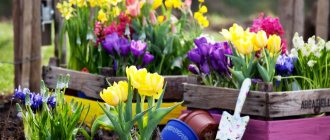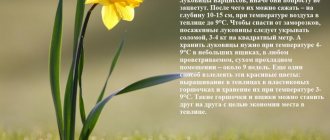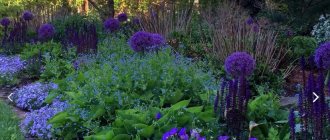At the end of the agricultural season, summer residents usually have free time for work for which they often lack it in the spring - for redevelopment, moving flower beds, dividing and replanting plants that have grown excessively in the garden. Many annual, biennial and perennial flowers are planted in the fall. There are several reasons for this: natural scarification and stratification necessary for pecking slow-germinating seeds, hardening of the seed, earlier and more luxuriant flowering in the summer.
If you plan to plant perennial flowers in the fall, before winter, it is important that they have time to take root before the onset of persistent frosts
Advantages of winter sowing of flowers
- Save time. Flowers require a lot of care. Therefore, having planted them before winter, you will not need to grow seedlings and will have free space on the windowsill for other heat-loving plants.
- Hardening off seedlings. Plants sown late in autumn and winter are more resistant to temperature changes, diseases and pests.
- Early flowering. Winter flowers bloom 2 weeks earlier than those planted in early spring through seedlings.
- Seed stratification. There are flowers that must undergo stratification before starting to grow. That is, when sowing in spring, manufacturers recommend keeping the seeds in the refrigerator. And in winter, in the ground, the seeds will go through this process under natural conditions.
- In the fall, you can sow seeds that are reaching the end of their shelf life.
If the seeds do not germinate well after winter sowing, you will have the opportunity to re-sow in the spring
Disembarkation rules
Where to plant
Sowing flowers before winter can be done directly in the front garden or in a special seedling school. In the garden, flower growers use high beds.
You can also plant flower seeds under a greenhouse roof.
In order not to replant annual flowers, it is better to prepare flower beds at the end of the autumn period.
Soil preparation
In the central zone of the Russian Federation, preparation of land for autumn planting of annual plants begins at the end of September or early October, in the south - in the first half of November.
If the season turns out to be warm and dry, you can start working whenever you want.
The main thing is that the temperature is above zero and there is no precipitation. When preparing, you need to follow this procedure:
- Gardeners weed, dig and loosen the soil, then level it with a rake.
- On the site, with the tip of a hoe, summer residents outline the contours of the future flower bed. They must be deep, clearly defined, so that they are not washed away by rain and snow.
- Then you should start drawing holes for the flowers (you can make them twice as deep as usual, since the soil will subside over time). The finished beds will need to be left until sub-zero temperatures are set.
In addition to the beds, you will need to prepare a substrate before frost. To do this, summer residents advise adding peat and sand to the garden soil in a ratio of 1:2:1 or buying a ready-made mixture.
The mixture should not be stored outdoors or in garden buildings, otherwise it will freeze and harden.
When frosts begin, and the forecast does not foresee a thaw for at least two weeks in a row, you can begin sowing.
In the autumn, it is worth pouring twice as many seeds as in the spring months. Flower growers plant them in frozen holes and cover them with prepared substrate. The planting site is fenced off with boards so that the seed is not washed away by precipitation (sheets of plywood or pieces of slate are suitable).
In each bed, it is advisable to put a plastic sign with the names of the plants.
Preparing the site for winter sowing
It is better to prepare the soil in advance.
To plant seeds in the fall, the soil must be prepared in advance. Seeds are sown in frozen soil, and in this case it will be very difficult to loosen it.
It is necessary to choose a place protected from strong winds, which is located at a slight elevation, since if moisture stagnates, the seeds will simply rot. Ideally, make a separate bed 15-20 cm high, supporting it with sides. In such a ridge, the water will drain faster and the soil will warm up faster in the spring.
Also, before sowing, study the needs of the flower, because there are plants that easily tolerate transplantation, and there are those that do not take root well when transplanted. Therefore, the latter need to be sown in a permanent place immediately.
Once you have decided on the bed, you need to carefully dig it up and clear it of plant debris and weed roots so that they do not interfere with the sprouting of flowers in the spring.
When digging, it is necessary to add humus, at a rate of 4-6 kg per sq.m., or phosphorus-potassium fertilizers at a dose of 15-20 g per sq.m. If the soil is heavy, it must be loosened well and mixed with river sand.
Delphinium
For winter planting, only fresh seeds should be used. Light, loose soil is suitable.
The area should be well lit by the sun and protected from wind and drafts.
Deepen the material 2 cm, after which you should cover it with a layer of mulch.
How to sow flower seeds before winter?
Before sowing, the seeds do not need to be soaked and germinated; they are sown only dry so that they do not germinate too early. Also, the weather should be dry at the time of sowing.
Since sowing before winter has a risk of freezing, it is necessary to increase the seed sowing rate by 25-50%.
Due to the fact that in winter the soil becomes very compacted, it is necessary to reduce the depth of sowing seeds compared to spring planting. It is better to crush the seeds with a thin layer of peat, sand, humus or a mixture of these components. To protect against frost, crops are covered with agrofibre, fallen leaves or straw.
After sowing, the seeds should not be watered so that they do not germinate in advance and freeze in winter.
Peat, straw, fallen leaves, agrofibre or film are perfect for mulching the ground.
Phlox Drummond
This plant is an annual crop. It is frost-resistant, so it can be sown before winter. Consider in advance that in the case of early spring, sprouts will appear quickly and may die if frost returns. It is advisable to cover phloxes after sowing seeds.
The shelter can be made quite simple. Stretch small arcs and cover them with film. You can also cover it with wooden boxes covered with film.
Annual flowers to plant in winter
Before winter, annual cold-resistant flowers with a short development period from germination to flowering are sown. They can be sown directly into the flowerbed or with subsequent transplantation. For example, delphinium does not tolerate transplantation well; this must be taken into account when choosing a site.
Flowers can also be sown in containers or pots. But if you want them to sprout early in the spring, the containers in which the seeds are sown need to be buried in the ground, and a drainage layer and holes should be made at the bottom of the pot so that excess moisture does not stagnate.
So, what kind of seeds of annual flowers can be planted before winter?
Alyssum (Lobularia)
Photo of alyssum
This is the best flower for dry and rocky places and is popular among gardeners. Its flowering begins in early May and lasts until frost.
Sowing this flower in winter will allow you to obtain healthy and stable seedlings in the spring. The seeds are very tiny, so they are mixed with sand before sowing.
When choosing a site, you need to take into account that alyssum blooms best in loose and well-moistened beds.
Sowing must be done in frozen soil and then mulched with peat, humus, agrofibre or film. The seedlings need to be thinned out, because when planted too thickly, fungal diseases may appear on them. The recommended sowing pattern is 15x20 cm.
- Mountain gold seeds of alyssum (lobularia, mason, alyssum) multi-colored. (Hem Zaden Mon)
Code: #2091
Price from: 8.00 UAH
- Hit of the Season 2021
Kamennik mixture (mix) 1 l. (alissum, lobularia) seeds (Moravoseed)
Code: #2276
Price from: 6.00 UAH
- Royal carpet mixture (mix) seeds of alyssum (lobularia, mason) one liter. mixture (Hem Zaden PN)
Code: #3356
Price from: 7.00 UAH
Annual aster (Callistephus sinensis)
Aster annual
A popular flower that came to us from China. Translated from ancient Greek, “Kallistephus” means “star”. Now it can be found in city flower beds, garden beds, front gardens and in containers. When sowing aster in winter, the risk of developing fusarium, which often affects this flower, is reduced.
For growing callistephus, a sunny area where marigolds or calendula previously grew is suitable. It is advisable to raise the beds by 15-20 cm. Before planting, the soil should be shed with Fitosporin to disinfect it from fungal diseases. The recommended planting pattern for annual aster is 20x35 cm. Sowing depth is 2 cm. Then the beds should be sprinkled with dry soil and insulated with sawdust or light peat.
- Hit of the Season 2021
Princess mixture (Mix) aster seeds one liter. 60cm (Moravoseed)
Code: #1539
Price from: 6.00 UAH
- Low purple aster (Purple) cut seeds, single size. 25cm (Moravoseed)
Code: #1572
Price from: 6.00 UAH
- Aster low mixture (Mix) for cutting seeds one liter. 25cm (Moravoseed)
Code: #1573
Price from: 6.00 UAH
- Harlequin pink (Pink) pompom-shaped aster seeds per cut one size. 65-70cm (Satimex PN)
Code: #9820
Price from: 9.00 UAH
Marigolds (Tagetsy, Chernobrivtsy)
Marigolds (Tagetsy)
In addition to its beauty, this flower is very useful in the garden. Exudations from its roots repel nematodes and help reduce plant disease.
You can also make infusions from the marigold plants themselves to control pests on vegetables.
Tagets are a heat-loving plant, for this reason they are sown before winter only in the southern regions. Upright, deflected and thin-leaved marigolds are suitable for this method of growing. These flowers tolerate partial shade well, but bloom best in sunny areas.
You can sow seeds after frost sets in in the furrows, which are then covered with soil that has been stored in a warm place. Then the crops are covered with agrofibre or a mini-greenhouse is made for them.
- Hit of the Season 2021
Marigolds spreading low carmine seeds one liter. 25-30cm (Moravoseed)
Code: #1068
Price from: 6.00 UAH
- Chicago Formula mix (Chicago Formula mix) American marigold seeds 15-20cm (Kitano Seeds)
Code: #1292
Price from: 258.00 UAH
- Antigua F1 mixture (mix) marigold seeds 25-30cm one liter. (Syngenta)
Code: #2139
Price from: 39.00 UAH
- Equinox lemon marigold seeds 25-30cm (Hem Zaden PN)
Code: #3280
Price from: 11.00 UAH
Did you know that seasoning is made from marigold petals? Then we suggest you look at our article “Edible flowers and their types.”
Winter sowing of marigolds
Godetia
Godetia
A flower with a wide variety of colors that will decorate any flower bed. It is often planted around flower beds, in pots and containers.
But godetia, like marigolds, prefers to grow in areas with warm winters.
It is recommended to sow immediately in a permanent place. A flower bed that is in the sun is suitable for this. The seeds are very small, so the sowing depth should not exceed 0.5 cm.
Crops need to be insulated for the winter so that they are not damaged by frost and excess moisture. In spring, it is recommended to thin out the crops so that the distance between plants is at least 25 cm.
- Hit of the Season 2021
Godetia large-flowered mixture (mix) seeds one liter. 20-40cm (Moravoseed)
Code: #2211
Price from: 6.00 UAH
- Rembrandt godetia azalea seeds 45cm (Hem Zaden)
Code: #17547
Price from: 9.00 UAH
- Southern Beauty Godetia grandiflora seeds 45cm (Hem Zaden)
Code: #17548
Price from: 9.00 UAH
Calendula (Marigold)
Calendula (Marigold)
Calendula got its second name “marigold” because its seeds look like a cat’s claw. The plant is distinguished by its unpretentiousness, so even an inexperienced gardener can grow it. This flower is cold-resistant, making it ideal for winter sowing.
Any soil is suitable for growing; the plant takes root easily after transplantation, so it can be planted where it is convenient. Sowing begins when the average daily temperature is at 0°C and there are slight frosts at night. At temperatures above +5°C, the seeds may hatch in winter and will not tolerate frost well. The seeds are sown dry in holes 4 cm deep and a distance between them of 15-25 cm, then sprinkled with dry soil and mulched with humus or straw.
Interesting fact. If you plant calendula around a vegetable plot, it will repel the Colorado potato beetle.
- Calendula orange (orange) seeds one liter. 50-60cm (Moravoseed)
Code: #2224
Price from: 6.00 UAH
- Calendula terry mixture (mix) seeds 25-30cm (Hem Zaden PN)
Code: #3347
Price from: 9.00 UAH
- Hit of the Season 2021
Pink surprise calendula seeds 20-25cm (GL Seeds)
Code: #16452
Price from: 6.00 UAH
- Green heart calendula seeds 50-60 cm one liter. (Helios)
Code: #17817
Price from: 18.00 UAH
Kosmeya (Space)
Cosmea
Each of us often sees cosmos around houses, near entrances and in city flower beds. It is very popular for such plantings because it is completely unpretentious to grow, is propagated by self-seeding and has an exquisite appearance.
Cosmos is sown immediately in a permanent place, well-lit by the sun with light soil. Seeds are sown in 3-4 pieces at a distance of 30-40 cm from each other. Then the cosmos seeds are sprinkled with earth so that they are at a depth of no more than 0.5 cm.
Then the crops are insulated with straw or agrofibre. You should not apply a lot of fertilizer to this flower, because it will increase the vegetative mass and not bloom. In the spring, the plants need to be thinned out, because the more space the cosmos has, the more luxuriantly it blooms.
- Hit of the Season 2021
Sensation mixture (mix) terry cosmos seeds 70-80cm (Hem Zaden PN)
Code: #10838
Price from: 7.00 UAH
Lavatera (Wild Rose)
Lavatera
Another flower that every gardener can grow. The plant does not require special care and grows well in flower beds and pots. Its large flowers open in late spring and bloom until mid-autumn.
Lavatera develops best in an area with good lighting and light, loose soil. It is necessary to feed a wild rose only if the soil is very poor and depleted.
For the winter, seeds are sown in a permanent place to a depth of 1 cm. To protect them from freezing, the crops must be covered with film or agrofibre. In order for the flowers to develop well, the crops need to be thinned out in the spring. So the recommended planting pattern for lavatera is 20 by 25 cm.
- Hit of the Season 2021
Lavatera mixture (mix) seeds one liter. 0.8-1.2m (Moravoseed)
Code: #2264
Price from: 8.00 UAH
- Silver glass mix (mix) lavatera seeds 50-60cm (Hem Zaden)
Code: #17413
Price from: 8.00 UAH
Phlox Drummond
Phlox Drummond
As the famous German collector K. Foster said: “A garden without phlox is a mistake.” Because this flower looks great both in compositions with other flowers and alone.
Among the 50 species of phlox, Drummond's phlox is an annual; all the rest are perennial flowers. It is cold-resistant, so gardeners often sow it before winter, or rather at the end of November.
When choosing the exact time for sowing, you need to take into account that even with slight warming, the seeds can germinate and young plants will die from frost. For sowing, choose beds where the soil is neither too heavy nor too light. Because in the first case, the plant will suffer from rot due to stagnation of moisture, and in the second, the roots will quickly dry out due to lack of water.
Seeds are sown in small grooves of 2-3 pieces with a distance between future plants of about 15 cm. The areas where phlox is sown must be insulated, but it is better to make small greenhouses from arcs covered with film. In spring, excess shoots are thinned out, leaving the strongest shoots.
- Hit of the Season 2021
Phlox Drummond mixture (mix) seeds one liter. 25cm (Moravoseed)
Code: #2364
Price from: 6.00 UAH
Eschscholzia (California poppy)
California poppy
Sowing before winter is ideal for growing Eschscholzia, as the seeds undergo natural stratification and begin to bloom much earlier than with spring sowing. Californian poppy does not like replanting, so it is immediately planted in a permanent place. To do this, choose well-lit flower beds. Seeds mixed with sand are sown in small furrows. Crops need to be mulched with a thick layer of dry leaves.
Interesting fact. Eschscholzia blooms only on sunny days and closes its fiery buds as soon as the sun sets below the horizon.
- Eschscholzia mixture (mix) seeds one liter. 40cm (Moravoseed)
Code: #1452
Price from: 8.00 UAH
Approximate list of perennials and rules for planting them
Perennials that winter in open ground are represented by both herbaceous and shrubby forms. Beautifully flowering and decorative foliage crops are sown with seeds and planted with rhizomes, bulbs, and corms.
The vegetative method of propagation is most effective and less traumatic in the fall. Plants are well adapted to the local climate, as a rule, they are unpretentious and undemanding to care, so there is no need to prepare them for wintering in a special way. Manipulations are carried out in favorable weather, when the drying heat has subsided, drizzling rains have increased air humidity and moistened the soil. The plants gained strength after flowering and accumulated enough nutrients in the rhizomes and bulbs.
How to organize proper care for peonies and lilies after flowering is described in detail in articles on our website
At a pre-selected site, weeds are removed and mineral fertilizers are applied, which will serve as additional nutrition for the seedlings in the spring. Planting is carried out from the beginning of September to October , approximately two to three weeks before the final drop in temperatures and cooling of the soil, but in such a way that the planting material does not begin to grow.
The depth of the holes and pits depends on the size of the rhizomes and bulbs. Before planting, they are carefully examined for signs of diseases and pests; spoiled ones are discarded; healthy ones are treated with appropriate fungicides for preventive purposes. Some of the perennials need to be cut off the above-ground dying part before winter.
With this approach, some biennials can bloom as early as next year. Thus, when sowing any asteraceae (zinnias, daisies, heleniums, rudbeckia, echinacea) in winter, the risk of fungal diseases that cause serious damage to these flowers is reduced.
Rudbeckia
, which blooms until frost, looks great in mono-beds and mixborders
Before winter, without fear, you can sow, divide and plant foxglove , hollyhock , geranium , lavatera , daylilies , bergenia, cottonweed, corydalis , anemones , lumbago , gentian , colchicum , gypsophila , primrose , alpine aster , lupine , hostas , all types of euphorbia , creeping carnation , heuchera , astilbe , peonies , irises , aquilegia , cornflower , lavender , lilies of the valley . It is impossible to list all the names. Almost any spring- and summer-blooming bulbous flowers take root well: muscari , allium , lilies , hyacinths , tulips , fritillaria , daffodils , scillas , pushkinias , chiodinoxes .
The popular primrose muscari is familiar to many amateur gardeners as “mouse hyacinth”
To protect attractive bulbs and rhizomes from hungry mice and rats, provide them with adequate protection by placing them in fine-mesh, top-closing baskets or metal wire mesh. Plastic and wooden devices are completely unreliable in this regard. Additionally, use special ultrasonic repellent devices. The use of toxic poisonous substances and glue traps is not only inhumane, but also has a short-term result. The destroyed rodents will be replaced by others.
Cosmea
These flowers are characterized by excellent beauty and ease of care. The peculiarity of this crop is that it can reproduce by self-sowing. In the spring you will need to remove excess shoots.
Planting should be done in well-lit areas with well-drained soil.
In nutritious soil, plants only increase green mass, which negatively affects flowering.
alpine aster
It is not difficult to grow alpine aster from seeds. Sowing can be carried out both before winter and in May. The first option is preferable, because after cold stratification, germination rates improve. Given the small size of the material, it is first sown in containers and then dug into the soil.
Choose well-lit areas for alpine aster. Planting in partial shade is acceptable.
Give preference to raised beds to prevent water stagnation. After planting, cover the area with a layer of humus and mulch.
Godetia
If you don’t know what annual flowers can be used for winter sowing, this plant is well suited for decorating flower beds. Sowing seeds should be carried out in regions with warm winters.
Choose well-lit areas. The soil must be fertile. Then lay a layer of mulch to protect the flowers from frost.
How to properly design flower beds with conifers: the best compositions and combinations of plantsAnnual flowers for a flower bed or garden: photos with names
Bush hibiscus: photo, planting and care features
Iberis
Iberis looks original on the site. This plant can be used to frame a lawn or flower bed.
You should not actively care for Iberis. The only caveat is to protect plants from root rot. Therefore, it is better to plant among stones.











